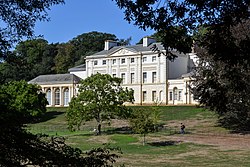| Kenwood House | |
|---|---|
 | |
| Type | English country house |
| Location | Hampstead Heath, NW3 |
| Coordinates | 51°34′17″N 0°10′3″W / 51.57139°N 0.16750°W |
| Area | London Borough of Camden |
| Built | 17th century |
| Rebuilt | 1764–1779 |
| Architect | Robert Adam (18th century remodelling) |
| Architectural style(s) | Georgian and Neoclassical |
| Owner | English Heritage |
Listed Building – Grade I | |
| Official name | Kenwood House (Iveagh Bequest) |
| Designated | 10 June 1954 |
| Reference no. | 1379242 |
Listed Building – Grade II* | |
| Official name | Service wing and outbuildings to Kenwood House |
| Reference no. | 1379244 |
Listed Building – Grade II* | |
| Official name | Sham bridge to south of Kenwood House |
| Reference no. | 1379245 |
| Designated | 1 October 1987 |
| Reference no. | 1000142 |
Kenwood House (also known as the Iveagh Bequest) is a stately home in Hampstead, London, on the northern boundary of Hampstead Heath. The present house, built in the late 17th century, was remodelled in the 18th century for William Murray, 1st Earl of Mansfield by Scottish architect Robert Adam, serving as a residence for the Earls of Mansfield until the 20th century.
The house and part of the grounds were bought from the 6th Earl of Mansfield in 1925 by Edward Guinness, 1st Earl of Iveagh, and donated to the nation in 1927. The entire estate came under ownership of the London County Council and was open to the public by the end of the 1920s. It remains a popular local tourist attraction.
